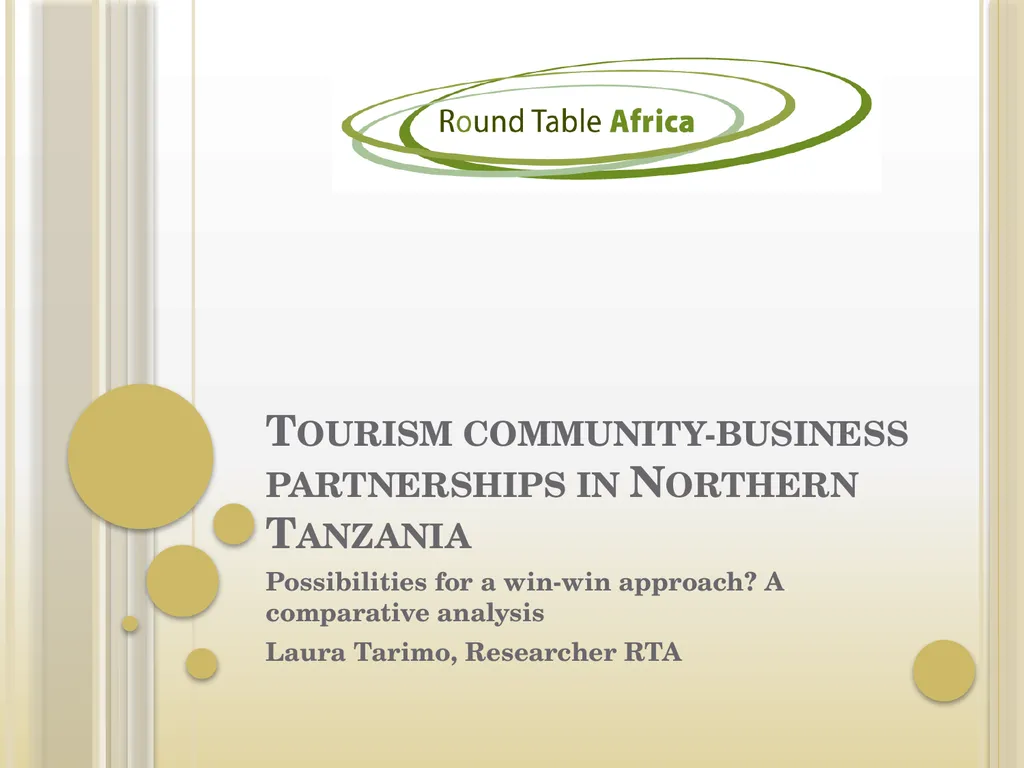Tourism community-business partnerships in
Author : ellena-manuel | Published Date : 2025-06-27
Description: Tourism communitybusiness partnerships in Northern Tanzania Possibilities for a winwin approach A comparative analysis Laura Tarimo Researcher RTA Background Tourism is a growing industry in Tanzania nearly 737000 tourists in 2008 an
Presentation Embed Code
Download Presentation
Download
Presentation The PPT/PDF document
"Tourism community-business partnerships in" is the property of its rightful owner.
Permission is granted to download and print the materials on this website for personal, non-commercial use only,
and to display it on your personal computer provided you do not modify the materials and that you retain all
copyright notices contained in the materials. By downloading content from our website, you accept the terms of
this agreement.
Transcript:Tourism community-business partnerships in:
Tourism community-business partnerships in Northern Tanzania Possibilities for a win-win approach? A comparative analysis Laura Tarimo, Researcher RTA Background Tourism is a growing industry in Tanzania (nearly 737,000 tourists in 2008 an increase of 11% since 2007 – TANAPA) Contribution to GDP of 65 million USD in 2008 (TANAPA) The proportion of tourism as part of the Tanzanian economy has grown from 7.5% in 1995 to 16% in 2002 (URT – MNRT) However, the level of development in rural areas has not changed much in the last 10 years (Wohlmuth, 2009) Tanzania remains an overwhelmingly agrarian country, with more than 70% of Tanzanians residing in rural villages and over 80% deriving their livelihoods from agriculture and pastoralism (URT, 2006) Economic development policy prioritizes supporting smallholder agriculture and increasing the linkages between rural livelihoods and macroeconomic growth (URT, 2006) So can the government create a win-win situation between communities and tourism businesses Research objectives To examine current practices / relations between companies in the tourism sector and local communities with respect to local economic development. To assess the potential for local economic development through agreements between communities and private sector firms. To identify ways in which the Government/ district provide an enabling environment for local economic development linked to tourism Main research question What are the benefits and the limitations of the different business-community tourism models for local economic development? Which tourism business-community model has most impact on local economic development? Which conditions are necessary to generate as much local economic development as possible? targetgroup Business = a private sector company or investor ‘‘Community’ is here used to refer to the village members living near or within the physical location Village is the village council and chairman and is part of the local government structure District government = local government authorities linking central government with villages Central government = government at the ministerial level. This study specifically considers the role of the Wildlife Division under the Ministry of Tourism & Natural Resources Three community-business partnership models I. Direct agreements: Business + Community (authorization required since 2008). II. WMA – Business + Community + District government with authorization of the Wildlife Division (MNRT). III. Hunting - (Transactional) agreements between business and central government. Research framework: partnership assessment using an input-output approach Based on literature research (Hailey (2000), van Dijk (2009), Pfisterer (2009), Spenceley (2008) five critical success factors (i.e. INPUTS) affecting the














